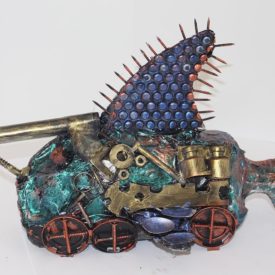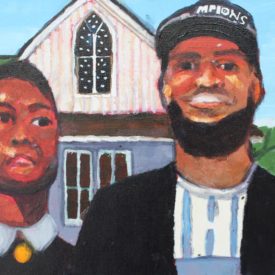A Guide for the Curious Curator
Max Vaughan, Year 12
I’m leaning on a streetlight on a dusky night at Claremont Train Station. Red taillights glow as they shoot past me. The penetrating sound of hard-work-shoe heel fills the silence of the crowded station. One man makes his way towards me. He’s walking a bike, stopping a metre before me and then placing it beneath him, balancing himself and the bike so he can accomplish a precarious and clearly practiced perch. This is Bob (I gave him that name). Bob’s a big bearded bloke, wearing a blue shirt and riding a black bike. He’s got a bit of a gut. Bob’s also a physiotherapist. You can see because he’s wearing a shirt that clearly reads ‘BodyMove Physiotherapy’.
Here comes the train! I let Bob go first, and as I enter the carriage and sit next to him – maintaining a cordial one seat distance – I catch a glimpse of Mel. Mel’s a middle-aged mum. Remember her for later. Bob’s left his bike up near the door. He looks like a trusting kind of guy, sitting in his seat, doing his little physiotherapy things. He sits up tall and arches his back, takes a big breath and rolls his shoulders. What’s going on in Bob’s brain? Does he yearn to be on the trails with his mountain bike, each day another tick on the weekend countdown? Does he have a wife and kids? Does he want to see them? Are all these mid-travel exercises some de-stressing ritual, preparing him for returning home to the domestic battleground? He seems like a grown-up kind of guy. Probably works long hours, leaves home at 7, gets back at 6:30. Kisses the wife goodbye and hello, then sits down to a dinner of beer and babs. Waiting for the weekend.
And what about Mel. She’s got her head in a phone right now, pulled back hair clearing her blue pale face illuminated by the blinking screen. Bags under her eyes, forehead crinkled up in ruts. Responsibility is heavy, isn’t it? Mel looks like Bob in ten years. Ten more years of dealing with kids. Ten more years of dealing with the same man. Ten more years at the same job. Ten more years. There isn’t much else too special about Mel. She’s wearing comfy clothes, a brown shirt and yoga pants. Mel nearly catches my eye, so my gaze hastily runs to the window. The trick to pretending you’re not looking is to look closely at something just near them, that usually satisfies them. I hate how I look in the glass. The train window gives me a fat lip and black eyes. A trick-of-the-light. It all rushes past, the cars, the grey road, the black sky, and with a woosh we’re in the tunnel.
Mel’s first to get up. Bob’s still on the train, on his way to where-ever he’s going on this Wednesday night. She absolutely fangs it up the stairs leaving Subi Station, and makes a quick right turn. She’s the first to tag off. The time’s about 5:34, but it’s already dark. Not dark enough for Kim though. Kim’s a crazy girl, or a boy. I can’t really tell. But it shouldn’t really matter, should it? Kim isn’t crazy because of that, though. Kim is crazy because she’s on a unicycle in a high-vis vest bombing down Railway Parade, weaving in and out of eucalyptus trees and footpath cracks. Taking my phone out, I snap a picture of her. It’s not every day you see someone on a unicycle. The flash blinks in and out and I store my new high-res photo of Kim on a unicycle. It’s so impressive how these days phones take such high definition photos.
I’m home now. Back in the den. It’s got a plate on the front called Lavender Cottage, but I like to call it ‘The Wolf Den’. Pretty crazy, huh? The blinds are down, and my single blue light is on, shedding the spotlight on to my phone and laptop. Facebook up. The first search of the day is ‘BodyMove Physiotherapy’. If you go into the search by person’s tab you can specify a place of work. Scrolling down the lists, I strike gold. Some people don’t have Facebook, but usually they’ve got some kind of social media, or their company has one of those ‘meet the team’ pages. Regardless, I always mark my man quickly enough. Big Bearded Bob is actually Big Bearded John. John Martin. Mr Martin has a beautiful wife – married five years ago. Her name is Kelsey White (nee Miller) and they have two kids: Ryan (1) and James (3). This is of course all neatly displayed on Mr Martin’s Facebook Timeline, a tidy summation of his life for the casual onlooker to happen across. If I wanted to see Johnno-mate again, I’d rock up to the Kalamunda Mountain Bike formal meeting on Saturday arvo, which he’s apparently attending as advertised on his events page.
That was quite an easy one, of course. Mel is going to be a bit harder, but thankfully our government has put infrastructure in place for the curious curator. Transperth logs all of the times smart-riders tag on or off. If you know where to look, you can find yourself on the archive of every single use of smart-riders over the last day. When you know the time (5:34), and the specific order of the person tagging off – first after the break between trains – suddenly you know the identification number of the smart rider. A couple of easy searches on Transperth later, and now we know Mel is actually Ella Ashton. Ella Ashton isn’t actually the middle-aged mum I thought she was. Bit prejudiced of me, really. She’s a working women lawyer at a high-flying firm. Apparently, she’s an integral part of the Women’s Law Society in WA. There’s a function for that group on Thursday week, in the late evening. Drinks 5-9. If I wanted to see her again.
The last one is Kim. Which would be near impossible without my high-res photo. There’s this cool new website online called PimEyes. I throw her photo on the net, and there it is, she’s returned from the ether. Kim is an active, genderfluid member of the LGTBQ community. If I wanted to see her and the unicycle, I would just have to attend a march on Parliament tomorrow at 2.
And that concludes my searching.








